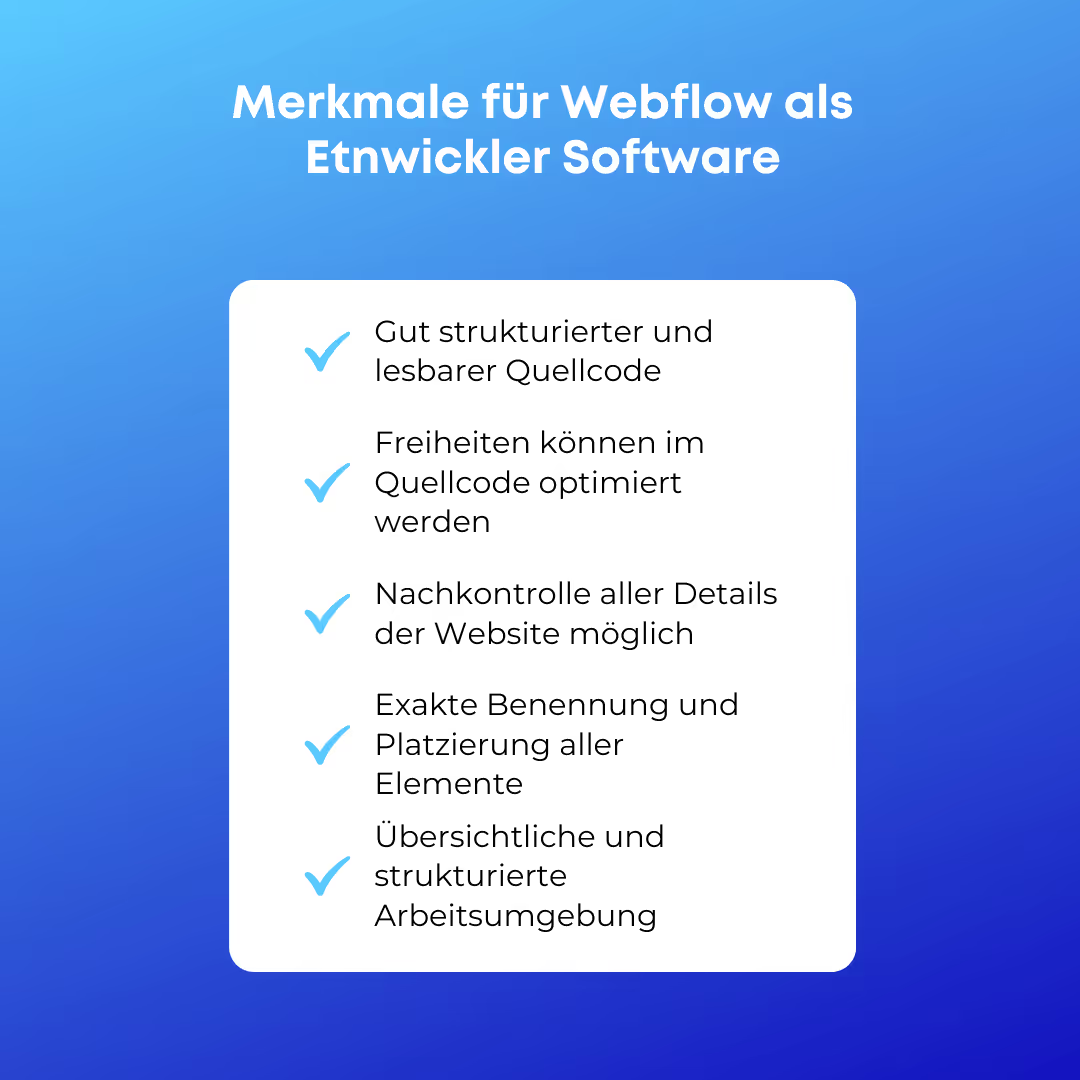Time and again, the question is whether Webflow is a CMS or developer software. It's not that easy to answer this question, because Webflow is both. And not just both half-hearted, but both in full. For this reason, more and more companies are working with Webflow as a CMS and rely on the simple version of no-code programming.
What is Webflow anyway and why is the software convincing?
Most users know website builders. These are sometimes more, sometimes less helpful and help to create simple websites even without knowledge of HTML. Unfortunately, these solutions are usually neither particularly convenient to use nor do they produce an easy-to-read source code. If the websites are to have additional functions, such solutions quickly reach their limits. Webflow, on the other hand, is not just developer software, Webflow is a CMS. This means that Webflow, as a CMS and developer software, first of all, offers a whole range of functions and options to create modern, elegant and, above all, highly functional websites. Both as a CMS and as a developer software, Webflow offers a whole range of functions that significantly simplify the design of websites.
As a low-code or no-code tool, Webflow has the big advantage that you don't need any programming knowledge to create a website or even a CMS function in Webflow. However, it is possible to manually intervene in the source code and change it at any time. This means that even experienced web developers can use Webflow as a CMS and developer tool, as the program significantly simplifies their work. In order to be able to better assess Webflow's capabilities as a CMS and as developer software, we first look at the most important functions of content management systems and developer tools and then see whether these functions are covered by Webflow as CMS and developer software. This makes it easier for you to decide whether you want to use Webflow CMS.
What makes a CMS stand out?
A content management system is probably the most advanced form of a website, because here content, i.e. content and design, are strictly separated from each other. The main advantage lies in greater flexibility and accessibility for content creators. The design of the entire page is developed and is the same on all pages. If new content is now created or existing content is adapted, this can be done without direct intervention in the underlying HTML code of the website.
The benefits of a CMS in detail
Companies in particular benefit significantly from a CMS, as the creation of new content is no longer linked to the ability to generate code. This means, among other things, that various employees can easily create new information and new content without the risk of jeopardizing the basic structure of the website. In addition, access and options can be restricted very precisely using the appropriate user rights. Among other things, it can be specified that certain content must always be filled out when creating new content or a new content page. This ensures that the appearance is consistent and consistent across the entire website. Ideal, in other words, so that users can enjoy a perfect user experience. We'll take a closer look at whether Webflow as a CMS also takes these important points into account.
What is developer software?
Developer software, on the other hand, is a solution that allows you to create entire websites or individual sub-pages in a simple process. For this purpose, the user of developer software usually does not have to have any HTML knowledge, but can design the website according to their own ideas using a simple editor. Competent developer software goes beyond the possibilities of the various website builders and is particularly impressive due to its ease of use. Nevertheless, developer software must be so complex that even highly complex websites can be easily created. The range of functions is the decisive criterion here.
Programming and software development — a good combination
As we already said in our article on the subject No code or low code Have clarified, good developer software tries to do a lot of work for the user and writes the visible changes into the website code itself. But that doesn't mean that the user no longer needs any programming knowledge at all for this reason. Because it can definitely be helpful to look at the code yourself in some places and also make manual changes there. In these cases, it is then important that the developer software is structured in such a way that it outputs good and, above all, understandable code. Unfortunately, this is not the case with all software, which can certainly lead to problems.
Regardless of whether Webflow is a CMS or developer software, this point must be considered in any case. Because it is only by being able to intervene manually and, if necessary, make changes to the source code yourself that the entire package makes sense in the first place. Good developer software is convincing in these areas and can make the lives of web developers easier in the long term. It is therefore important that the software is also constantly expanded with new functions, for example to adapt to new trends on the Internet or to include new versions of the programming languages.
Clear features for Webflow as a CMS
The Webflow as a CMS is convincing, among other things, in our Webflow CMS 101 already clearly shown. With the Webflow CMS, you can easily separate the content from the design of the website and the technology behind it, making it easier to work on the website. With Webflow CMS, you can also set up different rights for users in the backend, so that there are no problems here either if users make an incorrect input. A huge feature of the Webflow CMS is the specification of the individual fields for new pages. For example, when new content needs to be added to the website, users have various templates available. These templates can be used to define which mandatory fields must be completed, for example. For example, the fields for the metadata and also the authors could be marked separately. Among other things, this can significantly simplify the SEO optimization of a website if this data is filled out permanently and by every user.
Thanks to the simple and structured backend, Webflow as a CMS also offers significant advantages for the user. New pages are just as easy to create as existing pages can be modified and updated with new content. Users have great freedom in designing the content, but are still unable to impair the original design of the website and its functionality. For this reason, more and more companies are using Webflow as a CMS, as it combines both ease of use and a high level of security. Anyone who has already tried out different CMS and then tries out the Webflow CMS is usually always impressed. It's clear that the Webflow CMS focuses on usability for end users, but also for content creators.
-min.avif)
Features for Webflow as a developer software
Of course, Webflow has advantages as a CMS. But can the program also be convincing as a software developer? We can only answer “yes” to this question. Because Webflow is originally a development environment for websites, which works according to the simple principle of “What you see is what you get”. But Webflow is significantly different from simple website builders, which are offered in a variety of ways so that no one can keep track of things. Because Webflow not only offers a simple and clearly structured working environment, but also allows you to control and design all details of the subsequent website. When using Webflow as a developer software, you don't have to sacrifice any features or work with weird workarounds. Since Webflow, as a developer software, issues readable and well-structured source code, you can also adapt and optimize subtleties directly in the source code with the appropriate knowledge. It's like programming a website by creating an image in a graphics program. All elements can be precisely named and placed exactly. The logical structure of the functions and the website itself not only makes work easier, but is also an advantage if you want to change details again after a while. This is because you immediately recognize which elements belong to which content and can therefore make changes more quickly.

Conclusion: Webflow is both CMS and developer software
If you look at the various features, which we have listed in more detail here, it quickly becomes clear why more and more companies are using Webflow as CMS or developer software. Because Webflow CMS offers an enormous range of options and can therefore be easily used in a wide variety of environments.
Regardless of whether a single website needs to be built, a series of landing pages is required or a complete CMS is to be created. Thanks to Webflow and the CMS functionality, even highly complex websites can be easily created without having to manually interfere with the source code. As a user, you also benefit from the fact that you can define exactly which elements must be present in every new content page, for example to ensure a uniform image. Thanks to the simple regulation of user rights, companies can therefore be responsible for and change the content of the website themselves without the risk of anything being changed in the actual source code of the Webflow CMS. It is therefore ideal for building your own website quickly and sustainably, which meets a wide range of requirements.
Since Webflow is not only CMS but also developer software, there are also no weaknesses in the areas of design, functionality and usability. This allows experienced users to create highly complex and attractive websites, which are characterized by a short loading time and SEO optimization. You don't want to call Webflow a CMS and developer software an egg-laying milksow, but the solution in this area is damn close. For this reason, more and more web developers are switching to Webflow and are thus benefiting from the new opportunities and the variety of solutions.
In conclusion, it can be said that Webflow works excellently as a CMS and as a developer software and knows how to inspire with regard to the range of possibilities. This applies both to laymen in the field of website creation and to old hands who have programmed websites by hand over many years. Webflow makes work easier, more efficient and more enjoyable at the same time. In addition, as a CMS, Webflow is one of the best solutions on the market, precisely because the Webflow CMS combines all these functions and goes beyond the pure functionality of a normal CMS. Webflow CMS is therefore a real recommendation, which is confirmed by continuous enhancements and improvements of functions.









Recommend this post